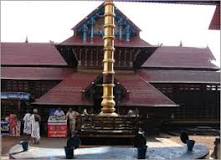Ettumanoor Mahadevar temple is one of the oldest, most popular and wealthiest of Shiva temples in the state of Kerala. The temple has rich a cultural legacy and is renowned the world over for its exquisite murals notable of which is the  'Pradosha Nritham' or the dance of the Lord (Shiva). Hundreds of thousands of devotees pay a visit to this popular shrine each year to seek the blessings of the generous Lord. The temple is built in the traditional Kerala style of temple architecture. Lord Shiva is enshrined in a circular shaped Sanctum Sanctorum or the Srikovil. A copper plated roof, conical in shape, covers the Sanctum and is crowned with a Kalasam. Ornate wooden carvings depicting scenes from the Ramayana and the Bhagavatha Purana adorn the walls of the Sanctum. The Sanctum's rear is considered to be the shrine of Goddess Parvathi as there is no separate Sanctum to enshrine the Goddess. Surrounding the sanctum is a rectangular circumambulatory passage. At the front is the Mukhamandapam, home to two beautiful images of Nandi, one of which is made up of metal while the other is of stone. A huge metal lamp welcomes devotees at the entrance to the temple. The soot formed from the burning of oil in this lamp is reputed to have medicinal properties and as such devotees pour oil in this lamp. The complex is also home to the shrines of Lord Sastha, Lord Ganapathi and Lord Dakshinamurthy. The star attraction at the temple is the 'Ezhara Pon Aana' or the seven and half elephants made of pure gold, which are put on display as part of the annual celebrations in February/March. These elephants represent the eight directions or the Ashta Dikpalaka and are called so as seven of these elephants are two ft. in height while height of the eighth is just one ft. Devotees consider a pilgrimage to the three Mahadevar temples, connected through the common legend of Demon Khara, at Vaikom, Ettumanoor and Kaduthuruthy on the same day a blessing.
'Pradosha Nritham' or the dance of the Lord (Shiva). Hundreds of thousands of devotees pay a visit to this popular shrine each year to seek the blessings of the generous Lord. The temple is built in the traditional Kerala style of temple architecture. Lord Shiva is enshrined in a circular shaped Sanctum Sanctorum or the Srikovil. A copper plated roof, conical in shape, covers the Sanctum and is crowned with a Kalasam. Ornate wooden carvings depicting scenes from the Ramayana and the Bhagavatha Purana adorn the walls of the Sanctum. The Sanctum's rear is considered to be the shrine of Goddess Parvathi as there is no separate Sanctum to enshrine the Goddess. Surrounding the sanctum is a rectangular circumambulatory passage. At the front is the Mukhamandapam, home to two beautiful images of Nandi, one of which is made up of metal while the other is of stone. A huge metal lamp welcomes devotees at the entrance to the temple. The soot formed from the burning of oil in this lamp is reputed to have medicinal properties and as such devotees pour oil in this lamp. The complex is also home to the shrines of Lord Sastha, Lord Ganapathi and Lord Dakshinamurthy. The star attraction at the temple is the 'Ezhara Pon Aana' or the seven and half elephants made of pure gold, which are put on display as part of the annual celebrations in February/March. These elephants represent the eight directions or the Ashta Dikpalaka and are called so as seven of these elephants are two ft. in height while height of the eighth is just one ft. Devotees consider a pilgrimage to the three Mahadevar temples, connected through the common legend of Demon Khara, at Vaikom, Ettumanoor and Kaduthuruthy on the same day a blessing.
History
The legend of the temple dates back much earlier than 1542 CE, which is when much of the temple structure was built. There are also references to some renovations during the same period – the sixteenth century CE. The popular seven and half elephants made of gold are presented to the temple by the Maharaja of Travancore.
Legends
According to the popular legend, Demon Khara impressed Lord Shiva with his worship at Chidambaram and was rewarded with three sacred Shivalingams. He carried them one in each hand and the other in his mouth. On the way, he rested at Vaikom and placed one of the Shivalingams on the ground only to find to his utter disappointment that it established itself on the ground. He later had to install the other two Shivalingams at Ettumanoor and Kaduthuruthy. Khara is also said to have enshrined Lord Krishna at the northwest of this temple.
Legend has it that Lord Shiva created a deer and allowed it play on an island. This island became part of Kerala when Lord Parasurama reclaimed land from the sea to create Kerala and thus this place came to be known as Maan-deer and oor –place – Maanoor.
According to another legend, the temple had to fall in to wilderness after the curse of sage Lomaharsha and was restored to its full glory by the great Villwamangalathu Swamiyar.
Festivals
The annual festival celebrated in the month of Kumbham (February/March) is a ten day affair with the celebrations being the talk of the region. The eighth and tenth days of this festival attract huge crowds as on the eighth, the Lord is taken in a huge procession and the popular seven and half golden elephants – the 'Ezharaponaana' are put on display.
Places of Interest
- The Mahadevar temple at Vaikom, The Lord Shiva Temple, Kaduthuruthy.
- The Subrahmanya Swamy Temple, Udayanapuram.
- The Thirunakkara Mahadeva Temple, Kottayam.
re just some of the popular religious destinations in and around the district.
Accommodation
Ettumanoor offers some facilities. However, the town of Kottayam, just 12 kms away, offers numerous options.